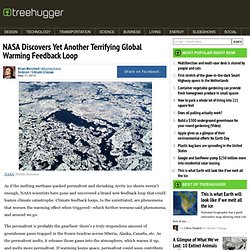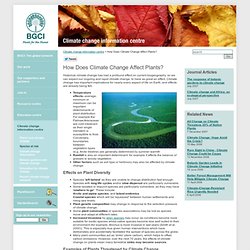

NASA Discovers Yet Another Terrifying Global Warming Feedback Loop. NASA/Public Domain As if the melting methane-packed permafrost and shrinking Arctic ice sheets weren't enough, NASA scientists have gone and uncovered a brand new feedback loop that could hasten climate catastrophe.

Climate feedback loops, to the uninitiated, are phenomena that worsen the warming effect when triggered—which further worsens said phenomena, and around we go. The permafrost is probably the gnarliest: there's a truly stupendous amount of greenhouse gases trapped in the frozen tundras across Siberia, Alaska, Canada, etc. As the permafrost melts, it releases those gases into the atmosphere, which warms it up, and melts more permafrost. If warming keeps apace, permafrost could soon contribute 35% of worldwide greenhouse gas emissions. Carbon-Belching Microbes Pose Yet Another Global Warming Feedback Loop. Mosieur via Flickr/CC BY 2.0 Perhaps the most frightening thing about climate change is that we don't have a great idea about exactly how fast it's going to get really frightening—if global warming activates any number of known feedback loops, temperatures could spiral out of control faster than our models currently predict.

Scientists are particularly concerned about the thawing permafrost and releasing the methane trapped within (the gas would trap more heat in the atmosphere and provoke more warming) and losing the Arctic sea ice that reflects sunlight back into space (as that ice surface dwindles, more heat is absorbed in the ocean, melting more ice).
There are many others, and each presents an unknown boundary that could throw a wrench into a system that's already going haywire—think of them as a collection of invisible trip wires that would screw everything over. NASA just uncovered another one—melting sea ice releases methane—and here comes yet another. Reversing climate warming by artificial atmospheric carbon‒dioxide removal: Can a Holocene‒like climate be restored? - MacDougall - 2013 - Geophysical Research Letters. Carbon Metabolism. Eat less meat to prevent climate disaster, study warns. Meat eaters in developed countries will have to eat a lot less meat, cutting consumption by 50%, to avoid the worst consequences of future climate change, new research warns.

The fertilisers used in farming are responsible for a significant share of the warming that causes climate change. A study published in Environmental Research Letters warns that drastic changes in food production and at the dinner table are needed by 2050 in order to prevent catastrophic global warming. It's arguably the most difficult challenge in dealing with climate change: how to reduce emissions from food production while still producing enough to feed a global population projected to reach 9 billion by the middle of this century.
The findings, by Eric Davidson, director of the Woods Hole Research Centre in Massachusetts, say the developed world will have to cut fertiliser use by 50% and persuade consumers in the developed world to stop eating so much meat. Davidson concedes it's a hard sell. New science reveals agriculture’s true climate impact. Photo by T.P. Martins. When I examined the reasons agriculture often gets a pass in climate negotiations recently, I pointed to the fact that precise measurement of the climate impact of many industrial farming practices remains difficult and controversial. This is especially true when it comes to synthetic nitrogen fertilizer. The effect of excess fertilizer on our waterways gets much more attention than it does when it enters the air. And for good reason. While we know that excess fertilizer escapes farm fields as gas, exactly how much and where it goes has largely been a mystery. Pinpointing the cause of these nitrous emissions has been made especially difficult by the fact that every molecule of nitrous oxide looks alike.
Climate Change Threatens Power Output, Study Says. As the climate gets warmer, so do the rivers and lakes that power plants draw their cooling water from.

And that is going to make it harder to generate electricity in decades to come, researchers report. Shawn Poynter for The New York TimesA cooling tower at the Big Sandy coal-fired plant near Louisa, Ky. In an article in the journal Nature Climate Change, scientists measured temperatures now and projected what they would be at midcentury. The temperatures vary according to the time of year, and, even if the extremes remain similar, they will be more frequent — meaning that the water will be too warm to allow full power production, they predict. All power plants that burn coal or split uranium, and most of the plants that burn natural gas, turn the resulting heat into steam, which spins a turbine that turns a generator to make power.
Extremely hot weather is not the norm today. It also pointed out that if rainfall patterns changed, hydroelectric dams would be less productive. How Does Climate Change Affect Plants? Historical climate change has had a profound effect on current biogeography, so we can expect our ongoing and rapid climate change, to have as great an effect.

Climate change has important implications for nearly every aspect of life on Earth, and effects are already being felt. Temperature effects–average, minimum or maximum can be important determinants of plant distributionFor example the Palmae/Arecaceae are cold intolerant as their single meristem is susceptible to frost.Conversely, boundaries between vegetation types (e.g.